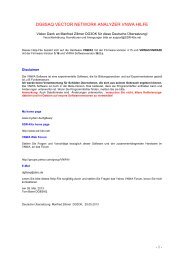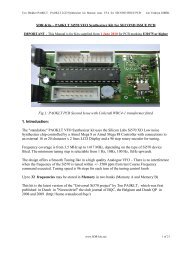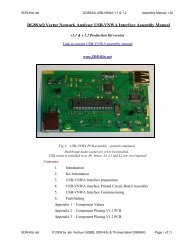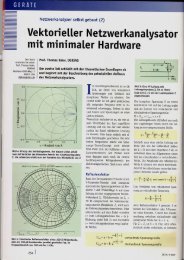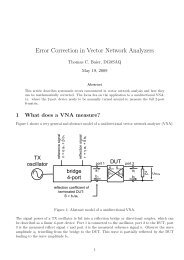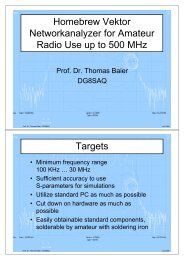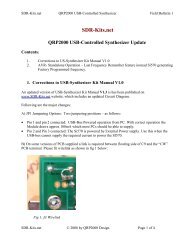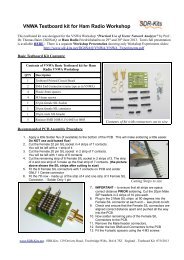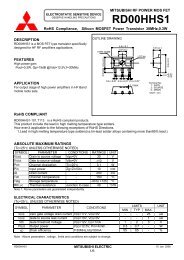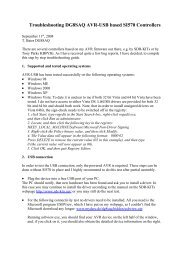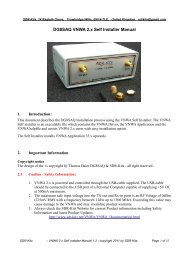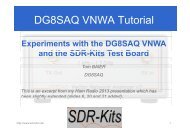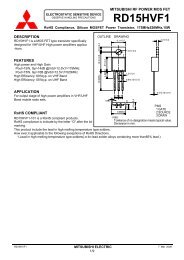Letters to the Editor - SDR-Kits
Letters to the Editor - SDR-Kits
Letters to the Editor - SDR-Kits
You also want an ePaper? Increase the reach of your titles
YUMPU automatically turns print PDFs into web optimized ePapers that Google loves.
and 40 MHz LO respectively. But <strong>the</strong>y alsoproduce alias frequencies; for example <strong>the</strong>first alias of <strong>the</strong> RF DDS is 180 MHz – 20MHz = 160 MHz. The second alias of <strong>the</strong>LO DDS is 170 MHz + 40 MHz = 210 MHz.Comparing <strong>the</strong> aliases in Table 1, <strong>the</strong>re isobviously only one pairing that yields a 20MHz IF when mixed. Note that <strong>the</strong> table doesnot show all possible mixing products of <strong>the</strong>shown aliases, but only those in <strong>the</strong> vicinityof <strong>the</strong> desired IF.Usually a DDS is used <strong>to</strong> produce lessthan 50% of its clock frequency. Table 2 displaysexample 2 where this is not <strong>the</strong> case.The DDS tuning words can still becalculated with <strong>the</strong> above formula. Thefundamental DDS frequencies are not <strong>the</strong>desired output frequencies, however. But <strong>the</strong>first aliases turn out <strong>to</strong> be exactly <strong>the</strong> wantedsignals. Also here, only <strong>the</strong> desired signalpair mixes <strong>to</strong> 20 MHz IF.Examples 3 and 4 in Table 3 demonstratewhat happens when <strong>the</strong> DDS tuning wordscalculated with <strong>the</strong> above formula exceed <strong>the</strong>word lengths of 32 bits. In this case, <strong>the</strong> leadingbits beyond bit number 32 are simply ignored.Thus, one arrives at 32 bit tuning words again.By doing this, it turns out that <strong>the</strong> DDS sourcesare set such that aliases produce exactly <strong>the</strong>desired frequencies. Again, only <strong>the</strong> desiredpairs produce <strong>the</strong> correct IF of 20 MHz.Finally, I would like <strong>to</strong> point <strong>to</strong> a very nicearticle by Sam Wetterlin, who has illustratedhow, by this idea and by making <strong>the</strong> clock frequenciesvariable, it is possible <strong>to</strong> constructa VNWA that covers a wide frequency rangewithout frequency gaps. 2A very small VNWA kit, which I hopewill cover a frequency range up <strong>to</strong> 1 GHz iscurrently under development. For informationon availability and pricing please visit <strong>the</strong> Website listed in Note 1.Thanks <strong>to</strong> Mike Alferman, WA2NAS, forstraightening out my manuscript.Notes1Professor Dr Thomas C. Baier, DG8SAQ, “ALow Budget Vec<strong>to</strong>r Network Analyzer for AF<strong>to</strong> UHF,” QEX, Mar/Apr 2007, ARRL, see alsowww.mydarc.de/DG8SAQ/VNWA/index.shtml2Sam Wetterlin, “Using DDS Aliases <strong>to</strong> Extend<strong>the</strong> Frequency Range,” www.wetterlin.org/sam/AD9952/MultipleClockAliases.pdfHigh Speed Multi-Media WorkingGroupDear Doug,Thank you most kindly, sir, for your warmcomments about <strong>the</strong> accomplishments of <strong>the</strong>League’s HSMM Working Group (WG) inyour edi<strong>to</strong>rial in <strong>the</strong> May/June 2007 issue ofQEX. The WG’s dedication and efforts areongoing, as reflected in many radio experimentersprojects.We are particularly proud of <strong>the</strong> excellentarticle in your same issue of QEX by WGmember Roderick D. Mitchell, KL1Y, “TheIntegration of Amateur Radio and 802.11”and your excellent presentation <strong>the</strong>reof.Thank you so very much for all your outstandingefforts <strong>to</strong> keep Amateur radio on <strong>the</strong>cutting edge of modern radio and electronicstechnology.— Very 73, John Champa, NCE (K8OCL),Wireless Systems Engineer, Rockwell Collins,Former Chairman, HSMM WG, 17850Sunmeadow Dr, Apt 2303, Dallas, TX 75252;k8ocl@hotmail.comHi John,Thanks also for all <strong>the</strong> work you and <strong>the</strong>all <strong>the</strong> members of <strong>the</strong> Working Group havedone, and continue <strong>to</strong> do. I agree that RodMitchell’s article is an interesting report onsome of that work.What else do you have <strong>to</strong> report? QEXstands ready <strong>to</strong> report on <strong>the</strong> WG’s efforts.If you or anyone else on your group would like<strong>to</strong> write for QEX, please submit your articles.— 73, Larry Wolfgang, WR1B, QEX ManagingEdi<strong>to</strong>r; lwolfgang@arrl.orgAu<strong>to</strong>matic Noise Figure Meter (May/June 2007)The subject article is a good example ofhow a measurement problem can be solvedby a little thought, without needing <strong>to</strong> buyor borrow expensive commercial equipment.Twenty or so years ago, I was faced with how<strong>to</strong> make NF measurements on some VHFand UHF very low noise amplifiers, but myuniversity research lab was not equipped witha noise figure meter.The solution was a calibrated noisesource, a broadband amplifier, a tunable bandpass filter and a power meter <strong>to</strong> measure <strong>the</strong>noise with <strong>the</strong> noise source off and <strong>the</strong>n on.All <strong>the</strong>se items were available in my lab. TheNF was calculated from <strong>the</strong> Y fac<strong>to</strong>r givenby <strong>the</strong> power meter. I never thought my ideawas new, but I was surprised <strong>to</strong> find that<strong>the</strong> vendor for <strong>the</strong> low noise amplifiers hadnever thought of using my procedure. He wassurprised <strong>to</strong> see that my measurements werequite accurate also.Good article!— 73, John H. Bordelon, PhD, K4JIU, 1690Hamp<strong>to</strong>n Oaks Bend, Marietta, GA 30066-4451; k4jiu@arrl.netHi John,Thanks for <strong>the</strong> compliments. We’re gladyou liked this article.— 73, Larry, WR1B.Components Cross ReferenceDear Sir,I have some data <strong>to</strong> help fill a hole in <strong>the</strong>HP cross reference <strong>to</strong> JEDEC or 300-hpxref.pdf. HP part number 1858-0054 is an exactmatch for an Intersil (RCA) CA3096 transis<strong>to</strong>rarray.We found this part in an Agilent servicemanual. By “we” I refer <strong>to</strong> a group <strong>to</strong> which Ibelong that promotes classic computer stuff.I’m also a proud ARRL member. Thanksfor helping us pass along this information!— 73, Steven Canning, PO Box 1682, LaMirada, CA 90638; cannings@earthlink.netOn <strong>the</strong> Crossed-Field AntennaPerformance, Parts 1 and 2(Jan/Feb and Mar/Apr 2007)Dear Doug,I feel <strong>the</strong> article on <strong>the</strong> Crossed-FieldAntenna was far below <strong>the</strong> technical levelset up <strong>to</strong> this point by QEX.I know <strong>the</strong>re is a great deal of discussionabout <strong>the</strong> <strong>the</strong>ory, but most knowledgeableantenna experts do not give this antenna anyreal credibility. In fact, <strong>the</strong> credit seems <strong>to</strong>go <strong>to</strong> <strong>the</strong> feed line.I always look forward <strong>to</strong> reading QEX andenjoy <strong>the</strong> level of articles presented. This onejust seemed out of place. It would have beenbetter placed in <strong>the</strong> April issue.— Doug Millar, K6JEY, 2791 Cedar Ave, LongBeach, CA 90806; dougnhelen@moonlink.netHello, Doug.I’m dismayed <strong>to</strong> see ano<strong>the</strong>r IEEE articlereprint that takes eight edi<strong>to</strong>rial pages inQEX. I have written previously <strong>to</strong> expressmy disappointment at reprinting verbatimarticles that appeared elsewhere. Post sucha reprinted article on <strong>the</strong> ARRL Web site, ifyou wish, but I pay for a QEX subscription <strong>to</strong>learn about new things of interest <strong>to</strong> communicationexperimenters. I have no interest inwading through dense ma<strong>the</strong>matics presentedpreviously in a professional-society publication.I doubt most o<strong>the</strong>r “experimenters” willei<strong>the</strong>r. To make matters worse, this article’ssecond part will take more edi<strong>to</strong>rial pages in afuture QEX. This isn’t <strong>the</strong> type of informationI signed up <strong>to</strong> receive in <strong>the</strong> pages of QEX, soI intend <strong>to</strong> let my QEX subscription lapse.— Jon Titus, KZ1G, 5526 West 13400South, Suite 105, Herriman, UT 84096;jontitus@comcast.netGentlemen,We are sorry that you did not enjoy <strong>the</strong>crossed field antenna article. Direct reprintsof previously published, readily availablearticles have been a rare occurrence in <strong>the</strong>pages of QEX. This research seemed <strong>to</strong> beworth sharing with QEX readers.I hope you will consider sharing someof your own work with our readers. QEX isdedicated <strong>to</strong> sharing experimental work andideas about a wide array of communications<strong>to</strong>pics.Jul/Aug 2007 3
Jon, I hope you will also reconsider yourdecision <strong>to</strong> allow your subscription <strong>to</strong> lapsebased on this one article. I hope you havefound many o<strong>the</strong>r articles of interest andthat you would look forward <strong>to</strong> reading moreexcellent articles in <strong>the</strong> future!— 73, Larry, WR1B.ARES Communications Pro<strong>to</strong>colEdi<strong>to</strong>r,I am interested in investigating an improvedcommunications and message traffichandling system for use in ARES deploymentsituations. I am both an Amateur Radio opera<strong>to</strong>rand a computer/information scientistand my experiences with existing UHF basedcommunications systems has shown <strong>the</strong> difficultiesinherent in voice-based, simplexcommunications and message handling.The situation I am attempting <strong>to</strong> address ishow <strong>to</strong> avoid overlapping transmissions whenoperating in a simplex mode (we are trainingfor a worst-case situation with no repeateravailability). The difficulty occurs when, insimplex mode, you have a network controlstation and remote stations, and <strong>the</strong> remotestations cannot hear each o<strong>the</strong>r but can communicatewith <strong>the</strong> control station. The realityis that <strong>to</strong>o often we have “collisions” whenremote stations transmit simultaneously, andin emergencies this delay and or loss of successfulcommunication could be fatal. Onesolution is for remote stations <strong>to</strong> call andwait for permission <strong>to</strong> transmit; ano<strong>the</strong>r is aroll-call pro<strong>to</strong>col. For standard voice communications,<strong>the</strong> call and wait pro<strong>to</strong>col makesgood sense and works well with disciplinedopera<strong>to</strong>rs. As we move <strong>to</strong> digital communications,however, <strong>the</strong>re are better ways <strong>to</strong> avoidmessage collisions and <strong>the</strong> au<strong>to</strong>mated roll-call(poll-response) initiated by <strong>the</strong> control stationis <strong>the</strong> one I am investigating. Packet or evencharacter format communications wouldappear <strong>to</strong> be readily available. The missingpieces in this system relate <strong>to</strong> <strong>the</strong> networklevel pro<strong>to</strong>col <strong>to</strong> control communications.The AGW suite of software and <strong>the</strong>AX25 Connected mode pro<strong>to</strong>col appear <strong>to</strong>have almost all of <strong>the</strong> features I am seeking,although not exactly in <strong>the</strong> way I want (pollresponse).Any information that your readership couldprovide on o<strong>the</strong>rs who are also looking in<strong>to</strong>, orworking on this same or related communicationspro<strong>to</strong>col would be greatly appreciated.— J.J. Hayden, KN4SH, 45 Cory Ct, Coving<strong>to</strong>n,GA 30016; jjhaydeniii@earthlink.netAntenna Options — NVIS Antennas forSpecial Needs (May/June 2007)LB’s article on discussing wide band NVISantennas shows so clearly <strong>the</strong> obsession manyhave with antenna matching. Here is an antenna(terminated V) that has at least four dBmore loss than an unterminated one, favoredby some purely because it matches <strong>the</strong> sourcebetter. Take <strong>the</strong> unterminated version and put a3 dB pad in front of it and <strong>the</strong> amplifier will behappy, and more RF will reach <strong>the</strong> destination!Obviously <strong>the</strong>re is more <strong>to</strong> life than SWR.I would call in<strong>to</strong> question one statement,though. “Since <strong>the</strong> … transmitter [scans] sorapidly, it does not have time for <strong>the</strong> delaysassociated with changing matching networks…”. There may be situations where this is true,but in general, it is very possible <strong>to</strong> design tunablematching networks using PIN diodes thatcan respond in microsecond time frames. ForHF, it is more challenging because PIN diodesthat can work down <strong>to</strong> 3 MHz are harder <strong>to</strong>come by, and will take longer <strong>to</strong> change state,but it is not impossible. High speed PIN diodedevices are not likely <strong>to</strong> dominate Amateurpractices anytime soon because of cost ando<strong>the</strong>r fac<strong>to</strong>rs. For military applications, however,such devices provide an alternative <strong>to</strong>wideband NVIS antennas.One of my clients manufactures tunableaircraft antennas that cover 30 <strong>to</strong> 500 MHz.This is a blade less than a foot in any dimension!It is used with military hopping radiosand can settle on a new operating frequency in10 µs. The radio sends <strong>the</strong> new frequency <strong>to</strong><strong>the</strong> antenna as a digital word and <strong>the</strong> microprocessorinside selects <strong>the</strong> proper combinationof PIN diodes <strong>to</strong> resonate this little blade <strong>to</strong>that frequency.— Wil<strong>to</strong>n Helm, WT6C, Embedded SystemResources, 320 Old Y Rd, Golden, CO 80401;whelm@compuserve.comHi Wil<strong>to</strong>n,I agree that in principle it is possible <strong>to</strong>reduce <strong>the</strong> transition time within <strong>the</strong> matchingnetworks <strong>to</strong> <strong>the</strong> very short interval thatyou indicate.Unfortunately, such tuning units are notpresently available — <strong>to</strong> my knowledge— at <strong>the</strong> frequencies indicated for amateurand related NVIS services at <strong>the</strong> powerlevels typically used and at a price that mostamateurs can pay. That is <strong>the</strong> context withinwhich my notes were applicable.I also agree that in principle SWR iscertainly not everything, but with typicalamateur transceivers <strong>the</strong> output impedance isfixed within a very small range with foldbackcircuits <strong>to</strong> limit final amplifier power when<strong>the</strong> SWR indication is greater than a certainthreshold. Hence, <strong>the</strong> amateur need <strong>to</strong> matchis a practical matter, not a <strong>the</strong>oretical one.An alternative <strong>to</strong> high-speed matching is,of course, slower speed ALE processing, sothat <strong>the</strong> speed of channel scanning matches<strong>the</strong> speed of available au<strong>to</strong>matic tuner switchingfor ATUs that already exist or that canbe developed <strong>to</strong> fit amateur budgets. Militaryand o<strong>the</strong>r services that need burst transmissions<strong>to</strong> keep channels and data secure mayrequire <strong>the</strong> very high speed of <strong>the</strong> latestALE processors, but <strong>the</strong> emergency servicesrendered by radio amateurs and many of <strong>the</strong>agencies involved in similar services do notneed such security — only efficiency.— 73, LB Cebik, W4RNL, 1434 High MesaDr, Knoxville, TN 37938; Cebik@cebik.com4 Jul/Aug 2007



